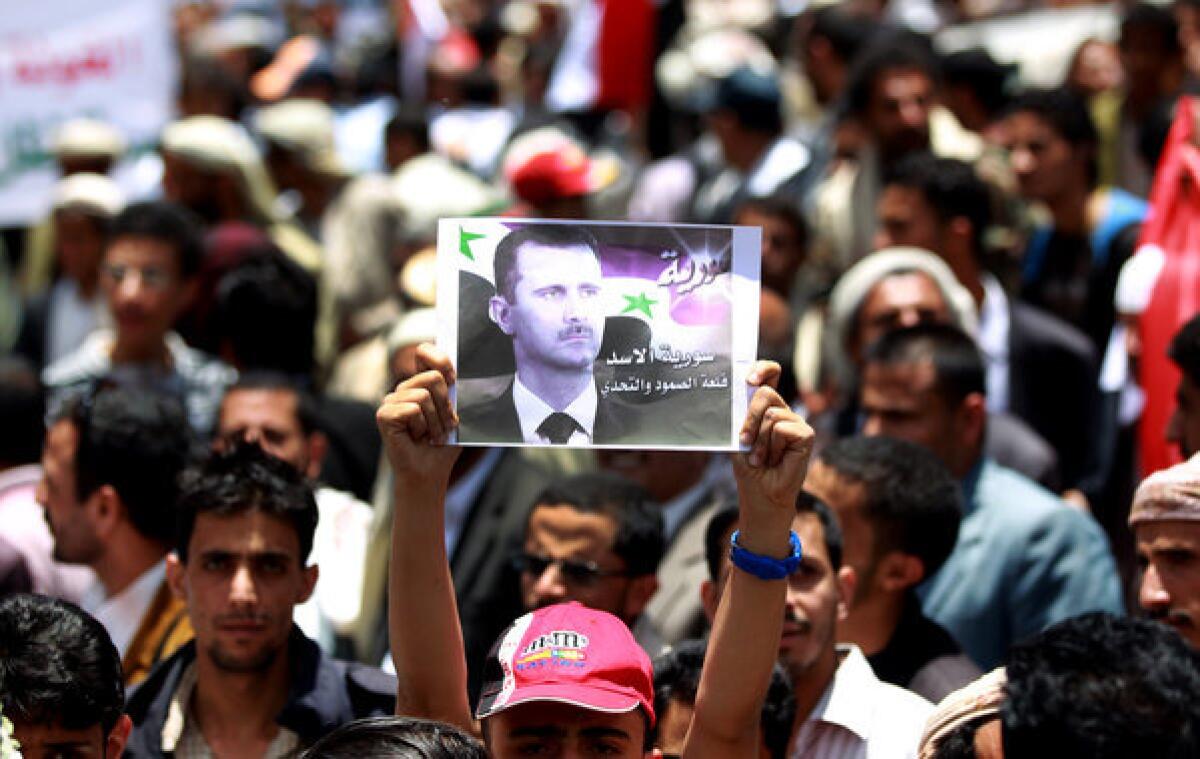Israeli attacks in Syria aimed at Hezbollah, not as aid to rebels

Israeli airstrikes in Syria on Iranian weapons destined for Lebanon’s Hezbollah militia could be seen as heralding wider international involvement in Syria’s intractable civil war.
Reports of sarin gas attacks in Syria also conjure the threat of further foreign intervention. President Obama has said any use of chemical weapons would “cross a red line.”
But Syrian President Bashar Assad and his backers in Iran and Hezbollah have responded to the latest signs of outside intrusion with little more than blustery vows to repel all enemies. The lack of specific threats of retaliation lends plausibility to a prevailing sense that Israel and its adversaries are engaged in a high-stakes game of chicken.
Israel, which hasn’t publicly admitted to bombing the weapons caches, appears to be confident that its airstrikes will be seen as preemptive defensive action to keep the weapons out of Hezbollah hands, not intervention on behalf of the rebels. Many of the groups fighting Assad are backed by Arab countries, Islamic political movements or armed factions that are declared enemies of Israel and would be loath to be seen as its comrades-in-arms.
As for concerns about Washington intervening militarily, its dubious decisions to go to war against Iraq and Afghanistan with the goal of regime change are likely curbing any appetite for fresh involvement in a faraway conflict, even with the reported chemical weapons use justifying more decisive action.
On Tuesday, the Alawite Syrian newspaper Al Watan reported that Assad had given a breakaway faction of Palestinian militants based in Damascus “a green light to attack Israeli targets.” Later in the day, though, Israel’s Haaretz newspaper quoted an unnamed senior member of the same group, the Popular Front for the Liberation of Palestine-General Command, as saying the warning was symbolic and not intended to spark renewed hostilities in the Golan Heights along the Syria-Israel border.
Assad can ill afford opening a new battlefront with nuclear-armed and heavily defended Israel, as his forces are hunkered down in the third year of fighting with motley factions of jihadists and insurgents across the country.
Syrian officials have branded the Israeli airstrikes “a declaration of war,” and Assad on Tuesday boasted after a meeting with visiting Iranian Foreign Minister Ali Akbar Salehi that his forces are “capable of facing Israel’s ventures.” Salehi warned that Israel was “playing with fire.”
But few familiar with the balance of forces and domestic interests at stake in and around Syria see much risk of Israel’s targeted strikes against Iranian-made Fatel-110 surface-to-surface missiles provoking a major escalation.
“Israel does not want to get involved in the Syrian conflict. But Israel has an interest in stopping the shipment of dangerous, game-changing weapons to Hezbollah,” former Israeli government minister and lawmaker Dan Meridor said, without confirming that Jerusalem was behind the airstrikes.
The fall of Assad would be a serious blow to Iran and Hezbollah, Meridor noted. But the rebel groups likely to fill the power vacuum in Damascus could prove even more problematic for Israel, he said, as some are aligned with Arab countries hostile to Israel or hard-line Islamic forces that deny Israel’s right to exist.
Charles Ries, a career diplomat and Middle East expert who is now vice president of Rand Corp.’s international division, described the Israeli action as “a propaganda cudgel” for the Syrian regime but unlikely to alter the course of the war.
“Assad will try to use the Israeli attack to discredit the rebels,” Ries said. “He will associate them with Israel and say they’re Israeli allies.”
As Assad and Salehi caucused in Damascus, the chief diplomats of the erstwhile superpowers scrambled to head off any escalation or further complication of the Syrian conflict.
U.S. Secretary of State John Kerry spent five hours in talks with Russian Foreign Minister Sergei Lavrov and President Vladimir Putin, resurrecting a dead-letter peace plan proposed in Geneva nearly a year ago. It calls for Assad and rebel representatives to engage in peace talks -- something both sides have firmly rejected.
Kerry, in remarks to reporters after the Moscow meetings, observed that the United States could hold off arming the rebels it supports if viable peace talks were underway. He also said that whether Assad goes or stays is a matter for the Syrian people to decide, stepping back from previous U.S. demands for Assad to resign before a new leadership can be negotiated. The U.S. policy shifts address Kremlin concerns that the United States is more focused on ousting Assad than ending the conflict.
But it remains unclear whether Moscow can compel Assad to sit down with the opposition figures he has branded “terrorists,” or if Washington can convince rebel leaders to meet with the autocrat they blame for 26 months of bitter fighting that has killed about 70,000.
Lavrov said he and Kerry agreed to try to assemble the parties as soon as the end of this month, and to try to salvage as much of the so-called Geneva communique as possible. Kerry also struck a more collaborative pose with his Russian counterpart, if not one that brimmed with optimism.
“Despite different points of view, committed partners can accomplish great things together when the world needs it,” Kerry said. “And this is one of those moments.”
ALSO:
U.S. and Russia to seek Syria peace talks
Obama, South Korean leader offer united front
Authorities arrest 31 in spectacular diamond heist
A foreign correspondent for 25 years, Carol J. Williams traveled to and reported from more than 80 countries in Europe, Asia, the Middle East and Latin America.
More to Read
Sign up for Essential California
The most important California stories and recommendations in your inbox every morning.
You may occasionally receive promotional content from the Los Angeles Times.










